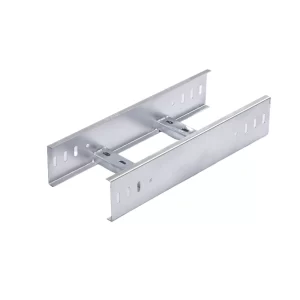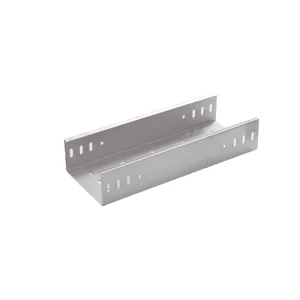Cable trays are an essential component of electrical installations, providing a structured and organized way to route and support cables. There are three main types of cable trays, each with its own unique characteristics and applications. In this article, we will explore these three types in detail.
Cable trays are used in a wide range of industries and applications, including commercial buildings, industrial facilities, and data centers. They offer several advantages over traditional conduit systems, such as ease of installation, flexibility, and the ability to accommodate large numbers of cables. By understanding the different types of cable trays, you can choose the most suitable option for your specific project requirements.

Ladder Cable Trays
1. Design and Construction
Ladder cable trays consist of two side rails connected by transverse rungs or steps. The rungs provide support for the cables and allow for air circulation around the cables, which helps to dissipate heat.
The side rails are typically made of metal, such as steel or aluminum, and can be coated for added corrosion resistance. The rungs are usually made of the same material as the side rails or may be made of a different material, such as fiberglass.
2. Applications
Ladder cable trays are commonly used in industrial settings where large numbers of heavy-duty cables need to be supported. They are suitable for both power and control cables and can handle high electrical loads.
These trays are often installed in areas where access to the cables is required for maintenance or troubleshooting. The open design of the ladder tray allows for easy inspection and installation of cables.
3. Advantages
One of the main advantages of ladder cable trays is their strength and durability. They can support heavy cables and are resistant to mechanical stress and impact.
The open design allows for good ventilation, which helps to prevent overheating of the cables. This is particularly important in applications where there is a high density of cables or where the cables carry large amounts of electrical current.
Ladder trays are also relatively easy to install and can be customized to fit specific project requirements. They can be cut to length, bent, and joined together using various fittings and connectors.
Channel Cable Trays
1. Design and Construction
Channel cable trays have a U-shaped or C-shaped cross-section, with a bottom and two sides. The sides provide support for the cables and help to contain them within the tray.
Like ladder trays, channel cable trays are typically made of metal, but they can also be made of plastic or fiberglass. The metal trays may be coated for corrosion resistance.
2. Applications
Channel cable trays are often used in commercial and institutional buildings where a more aesthetically pleasing appearance is desired. They are suitable for both power and data cables and can be installed in ceilings, walls, and floors.
These trays are also used in areas where there is a need for cable protection, such as in areas with high foot traffic or where the cables are exposed to potential damage.
3. Advantages
Channel cable trays offer a more enclosed design than ladder trays, which provides better cable protection. The sides of the tray help to prevent cables from falling out or being damaged by external forces.
They can be painted or finished to match the surrounding decor, making them a more visually appealing option for installations in visible areas.
Channel trays are also relatively easy to install and can be customized with various accessories, such as covers, dividers, and brackets.

Solid Bottom Cable Trays
1. Design and Construction
Solid bottom cable trays have a flat bottom and sides, creating a completely enclosed space for the cables. The trays are typically made of metal or plastic and may be coated or lined for added protection.
2. Applications
Solid bottom cable trays are used in applications where there is a need for maximum cable protection and containment. They are often used in harsh environments, such as industrial plants with dust, moisture, or chemical exposure.
These trays are also suitable for installations where there is a risk of electromagnetic interference (EMI) or radio frequency interference (RFI). The solid bottom helps to shield the cables from external electromagnetic fields.
3. Advantages
The enclosed design of solid bottom cable trays provides excellent cable protection. The trays can prevent dust, moisture, and other contaminants from entering and damaging the cables.
They offer good EMI/RFI shielding, which is important in applications where sensitive electronic equipment is used.
Solid bottom trays are also more resistant to physical damage than open or partially open trays. They can withstand impacts and abrasions, making them suitable for use in areas with heavy machinery or equipment.
Comparison of the Three Types
1. Strength and Durability
Ladder trays are generally the strongest and most durable type, followed by channel trays and then solid bottom trays. However, the strength and durability of each type can vary depending on the material and construction.
For applications with heavy cable loads or mechanical stress, ladder trays are often the preferred choice. For lighter loads or where aesthetics are more important, channel or solid bottom trays may be suitable.
2. Ventilation
Ladder trays offer the best ventilation, followed by channel trays. Solid bottom trays have the least ventilation, which can lead to heat buildup if not properly managed.
In applications where heat dissipation is a concern, ladder trays or channel trays with perforated bottoms may be a better option.
3. Cable Protection
Solid bottom trays provide the most cable protection, followed by channel trays and then ladder trays. However, the level of protection can also depend on the specific design and accessories used.
For applications where cable protection is critical, solid bottom trays or channel trays with covers may be necessary.
4. Aesthetics
Channel trays and solid bottom trays are often considered more aesthetically pleasing than ladder trays, especially in visible areas. They can be finished to match the surrounding decor and provide a neater appearance.
Ladder trays are more industrial in appearance and may not be suitable for installations where aesthetics are a priority.
The three main types of cable trays – ladder, channel, and solid bottom – each have their own unique characteristics and applications. When choosing a cable tray for a specific project, it is important to consider factors such as cable load, environmental conditions, ventilation requirements, cable protection, and aesthetics. By understanding the differences between these types, you can select the most appropriate cable tray to ensure a safe, efficient, and reliable electrical installation.
